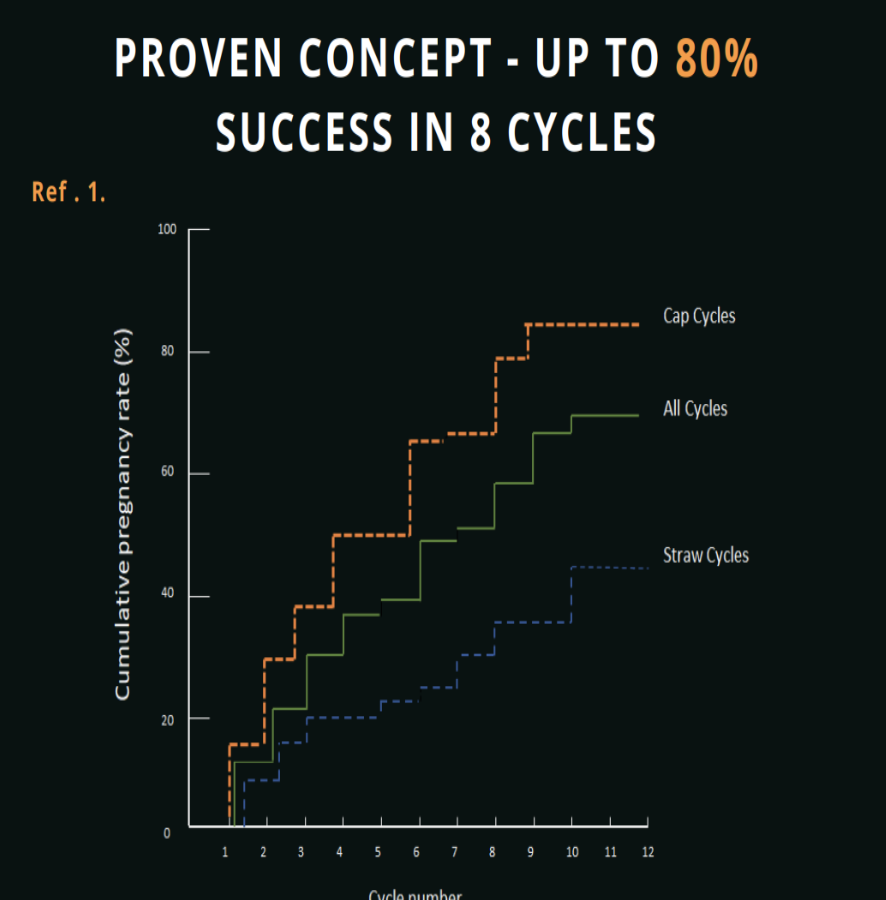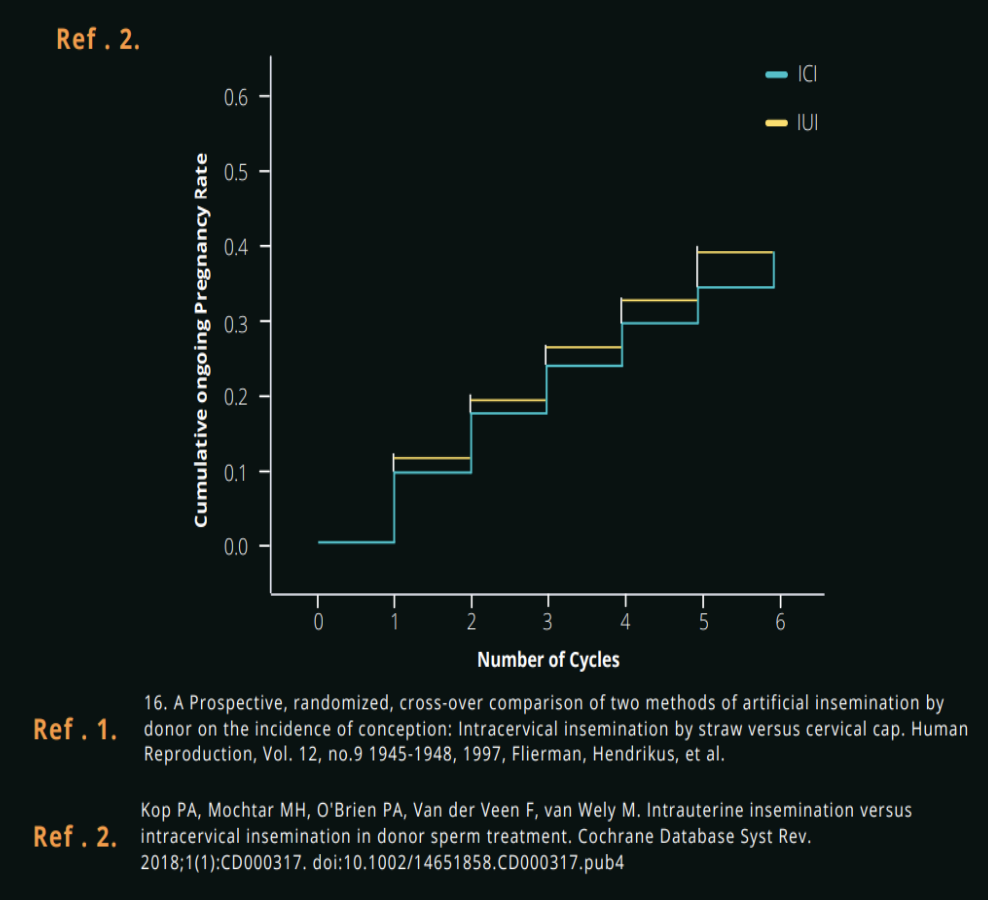The world’s most crucial cohort study “Intrauterine insemination or intracervical insemination with cryopreserved donor sperm in the natural cycle: a cohort study, The netherland “ IUI Vs ICI shows that insemination with ICI provides 40 % success in 6 cycles and 80% success in 8 cycles. A prospective, randomized, cross-over comparison of two methods of artificial insemination by donor on the incidence of conception: intracervical insemination by straw versus cervical cap.
This solution is 40-50 times cheaper than IVF, ( Rs 30K vs Rs 12- 13 lakh, considering six cycles before success comes )
we know that 100% of the patient can not be treated with this method, especially if the issue is related to women partner ( but this method is the best fit for 70% of population couples related to male or unexplained infertility -read FAQ for more information)


RESEARCH DATA ( WATCH VIDEO )
REFERENCES
The Invention have been backed by many research and trial, we understand reading those all is very time consuming and difficult. We we providing the research papers name below and three main papers (downloadable link) which can be read for efficacy point of view – which proves the 80% success of the concept.
Please download this two papers
The world’s most important cohort study (https://lnkd.in/d9GP_26) IUI Vs ICI shows that insemination with ICI provides the 40 % success in 6 cycles and 80% success in 8 cycles (https://bit.ly/2MLCtF8).
This solution is 40-50 times cheaper than IVF, ( Rs 30K vs Rs 12- 13 lakh, considering six cycles before success comes )
Other Reference papers
References
1. Infertility definitions and terminology. World Health Organization. https://www.who.int/reproductivehealth/topics/infertility/definitions/en/
2. Kumar, N., & Singh, A. K. (2015). Trends of male factor infertility, an important cause of infertility: A review of literature. Journal of human reproductive sciences, 8(4), 191–196.
3. Katole A, Saoji AV. Prevalence of Primary Infertility and its Associated Risk Factors in Urban Population of Central India: A Community-Based Cross-Sectional Study. Indian J Community Med. 2019;44(4):337–341.
4. Adamson PC, Krupp K, Freeman AH, Klausner JD, Reingold AL, Madhivanan P. Prevalence & correlates of primary infertility among young women in Mysore, India. Indian J Med Res. 2011;134(4):440–446.
5. Mother or nothing: the agony of infertility. Bulletin of World Health Organization. https://www.who.int/bulletin/volumes/88/12/10-011210/en/
6. Merchant R, Gandhi G, Allahbadia GN. In vitro fertilization/intracytoplasmic sperm injection for male infertility. Indian J Urol. 2011;27(1):121–132.
7. Allahbadia GN. Intrauterine Insemination: Fundamentals Revisited. J ObstetGynaecol India. 2017;67(6):385–392.
8. Cooper TG, Noonan E, von Eckardstein S, et al. World Health Organization reference values for human semen characteristics. Hum Reprod Update. 2010;16(3):231-45
9. World Health Organization. WHO laboratory manual for the Examination and processing of human semen. Fifth Edition. 2010. ISBN 978 92 4 154778 9.
10. Katole A, Saoji AV. Prevalence of Primary Infertility and its Associated Risk Factors in Urban Population of Central India: A Community-Based Cross-Sectional Study. Indian J Community Med. 2019;44(4):337-341.
11. Mascarenhas MN, Flaxman SR, Boerma T, Vanderpoel S, Stevens GA. National, regional, and global trends in infertility prevalence since 1990: A systematic analysis of 277 health surveys. PLoS Med 2012;9:e1001356.
12. Global infertility testing and treatment market forecast 2019-2027. https://www.inkwoodresearch.com/reports/infertility-testing-and-treatment-market/
13. Banerjee, K., & Singla, B. (2017). Pregnancy Outcome of Home Intravaginal Insemination in Couples with Unconsummated Marriage. Journal of human reproductive sciences; 10(4): 293–296.
14. https://www.fda.gov/medical-devices/premarket-submissions/premarket-notification-510k.
15. https://www.iso.org/obp/ui/#iso:std:iso:14971:ed-3:v1:en
16. A Prospective, randomized, cross-over comparison of two methods of artificial insemination by donor on the incidence of conception: Intracervical insemination by straw versus cervical cap. Human Reproduction, Vol. 12, no.9 1945-1948, 1997, Flierman, Hendrikus, et al.
17. Evaluation of the effect of a cervical cap device on sperm functional characteristics in vitro. ANDROLOGIA 33, (2001), M. C. Mahony.
18. The cervical cap for home artificial insemination. J. Reprod. Med., 1986, May; 31 (5):349-52, Corson, Batzer, Otis, Fee.
19. Randomized controlled trial of cervical cap with intracervical reservoir versus standard intracervical injection to inseminate cryopreserved donor sperm. Human Reproduction, Vol. 11, no.1, pp.84-87, 1996, C. Coulson, E.A. McLaughlin, S. Harris, W.C.L. Ford and M.G.R. Hull.
20. Postcoital Sperm Assessment Comparative Study. Clinical trial od STORK OTC https://clinicaltrials.gov/ct2/show/study/NCT02038322. Pelekanos MJ. SurgTechnol Int. 2015 Nov;27:184-90.
21. Therapeutic donor insemination: A prospective randomized trial of fresh versus frozen sperm.” Leslee L. Subak, MD, G. David Adamson, MD, Nancy L. Boltz, RNC. American Journal of Obstetrics &Gynecology, Volume 166, Issue 6, Part 1, June 1992. http://www.ncbi.nlm.nih.gov/m/pubmed/1615966/
22. The cervical cap for home artificial insemination.” Corson SL, Batzer FR, Otis C, Fee, D. Journal of Reproductive Medicine, May 1986; 31(5)349-52. http://www.ncbi.nlm.nih.gov/m/pubmed/3746786/
23. American Society for Reproductive Medicine: http://www.reproductivefacts.org/FACTSHEET_Intrauterine_Insemination_IUI/
24. Study of adaptability and efficacy of menstrual cup in managing menstrual health and hygiene. DOI: http://dx.doi.org/10.18203/2320-1770.ijrcog20172932. C. R. Kakani, Jalpa K. Bhatt
25. “Evaluation of male infertility with an in vitro cervical mucus penetration test.” Alexander, Nancy J. Fertility and sterility 36.2 (1981): 201-208.
26. Kop PA, Mochtar MH, O’Brien PA, Van der Veen F, van Wely M. Intrauterine insemination versus intracervical insemination in donor sperm treatment. Cochrane Database Syst Rev. 2018;1(1):CD000317. doi:10.1002/14651858.CD000317.pub4
27. Harper MJK. Sperm and egg transport. In: Austin CR, Short RV, editors. Reproduction in mammals: Germ cells and fertilization. Cambridge: Cambridge University Press; 1982; p. 102-27. [ Links ]
28. Brannigan RE, Lipshultz LI. Sperm Transport and Capacitation. Glob Libr Women’s Med. 2008, Available from: http://www.glowm.com/index. html?p—glowm.cml/section_view&articleid—315. [ Links ]
29. Sobrero AJ, MacLeod J. The immediate postcoital test. FertilSteril. 1962;13:184-9. [ Links ]
30. Moghissi KS. Cervical and uterine factors in infertility. ObstetGynecol Clin North Am. 1987;14(4):887-904. [ Links ]
31. Du Plessis SS, Gokul S, Agarwal A. Semen hyperviscosity: causes, consequences, and cures. Front Biosci (Elite Ed). 2013;5:224-31. [ Links ]
32. Jequier AM. Sperm transport in the human and mammalian cervix and genital tract: its relation to fertility. In: Jordan JA, Singer A, editors. The Cervix. 2nd ed. Oxford: Blackwell Publishing Ltd; 2006; p. 169-80. [ Links ]
33. Speroff L, Fritz MA. Sperm and Egg Transport, Fertilization, and Implantation. In: Speroff L, Fritz MA, editors. Clinical Gynecologic Endocrinology and Infertility. Philadelphia: Lippincott Williams & Wilkins; 2005; p. 437-87. [ Links ]
34. BoskeyER , Cone RA, Whaley KJ and Moench TR (2001 ) Origins of vaginal acidity: high D/L lactate ratio is consistent with bacteria being the primary source. Hum Reprod 16, 1809–1813.
35. Acott TS and Carr DW ( 1984 ) Inhibition of bovine spermatozoa by caudal epididymal fluid. II. Interaction of pH and a quiescence factor. BiolReprod 30, 926- 35
36. CarrDW ,Usselman MC and Acott TS ( 1985 ) Effects of pH, lactate, and viscoelastic drag on sperm motility: a species comparison. BiolReprod 33, 588 –595
37. Roberts SJ ( 1986 ) Veterinary Obstetrics and Genital Diseases, 3rd edn. Stephen Roberts, Woodstock, VT
38. Prevalence and epidemiological correlates of bacterial vaginosis among nonpregnant females at a tertiary care center in Assam, India
39. Barbonetti A, Cinque B, Vassallo MR, Mineo S, Francavilla S, Cifone MG, et al. Effect of vaginal probiotic lactobacilli on in vitro-induced sperm lipid peroxidation and its impact on sperm motility and viability. FertilSteril. 2011;95:2485–8. [PubMed] [Google Scholar]
40. Outcomes after intrauterine insemination are independent of provider type
41. https://www.sciencedirect.com/science/article/abs/pii/S0015028216599567
42. Chen TH., Chang SP., Tsai CF., Juang KD. Prevalence of depressive and anxiety disorders in an assisted reproductive technique clinic. Hum Reprod. 2004;19(10):2313–2318. [PubMed] [Google Scholar]
43. Sejbaek CS., Hageman I., Pinborg A., Hougaard CO., Schmidt L. Incidence of depression and influence of depression on the number of treatment cycles and births in a national cohort of 42 880 women treated with ART. Hum reprod. 2013;28(4):1100–1109. [PubMed] [Google Scholar]
44. Pasch LA., Holley SR., Bleil ME., Shehab D., Katz PP., Adler NE. Addressing the needs of fertility treatment patients and their partners: are they informed of and do they receive mental health services? FertilSteril. 2016;106(1):209–215. [PubMed] [Google Scholar]
45. Holley SR., Pasch LA., Bleil ME., Gregorich S., Katz PK., Adler NE. Prevalence and predictors of major depressive disorder for fertility treatment patients and their partners. FertilSteril. 2015;103(5):1332–1339. [PMC free article] [PubMed] [Google Scholar]
46. Lakatos E., Szigeti JF., Ujma PP., Sexty R., Balog P. Anxiety and depression among infertile women: a cross-sectional survey from Hungary. BMC Womens Health. 2017;17(1):48. [PMC free article] [PubMed] [Google Scholar]
47. De Berardis D., Mazza M., Marini S., et al. Psychopathology, emotional aspects and psychological counselling in infertility: a review. ClinTer. 2014;165(3):163-69. [PubMed] [Google Scholar]
48. Shani C., Yelena S., Reut BK., Adrian S., Sami H. Suicidal risk among infertile women undergoing in-vitro fertilization: Incidence and risk factors. Psychiatry Res. 2016;240:53–59. [PubMed] [Google Scholar]
49. Klonoff-Cohen H., Chu E., Natarajan L., Sieber W. A prospective study of stress among women undergoing in vitro fertilization or gamete intra fallopian transfer. FertilSteril. 2001;76(4):675–687. [PubMed] [Google Scholar]
50. An Y., Sun Z., Li L., Zhang Y., Ji H. Relationship between psychological stress and reproductive outcome in women undergoing in vitro fertilization treatment: psychological and hormonal treatment. J Assist Reprod Genet. 2013;30:35–41. [PMC free article] [PubMed] [Google Scholar]
51. Terzioglu F., Turk R., Yucel C., Dilbaz S., Cinar O., Karahalil B. The effect of anxiety and depression scores of couples who underwent assisted reproductive techniques on the pregnancy outcomes. Afr Health Sci. 2016;16(2):441–450. [PMC free article] [PubMed] [Google Scholar]
52. Xu H., Ouyang N., Li R., Tuo P., Mai M., Wang W. The effects of anxiety and depression on in vitro fertilization outcomes of Chinese women. Psychol Health Med. 2017;22:37–43. [PubMed] [Google Scholar]
53. https://www.cmaj.ca/content/189/10/E391
54. Kistoer RW. The infertile women. J Nurs 1973; 73: 1937
55. Asch RH, Greenblatt RB. Update on the safety and efficacy ofclomiphene citrate as a therapeutic agent. J Reprod Med1976; 17: 175
56. Gysler M, March CM, Mishell DR, et al. A decades’ experiencewith an individualized clomiphene treatment regimen including its effects in the postcoital test. Fertil Steri11982; 37: 161
57. Fedele L, Brioschi D, Marchini M, et al. Enhanced preovulatory
progesterone levels in clomiphene citrate-induced cycles. JC1in Endocrinol Metab 1989; 69: 681-3
58. Katz E. The luteinized unruptured follicle and other ovulatorydysfunctions. FertilSteril 1988; 50: 839-50
59. Mor-Joseph S, Anteby SO, Granat M, et al. Recurrent molarpregnancy associated with clomiphene citrate and human gonadotropins. Am J ObstetGynecol1985; 151: 1085.
60. Roland M. Problems of ovulation induction with clomiphenecitrate with report of a case of ovarian hyperstimulation. ObstetGynecol 1970; 35: 55
61. Scommegna A, Lash SR. Ovarian hyperstimulation, massiveascites and singleton pregnancy after clomiphene. JAMA
1969;207:753
62. Rojanasakul A. Massive ascites following induction of ovulation with clomiphene citrate: a case report. J Med Assoc Thai1988; 71: 86
63. https://academic.oup.com/humrep/article/30/3/603/662550
64. Comparison of the methods of artificial insemination on theincidence of conception in single unmarried women
